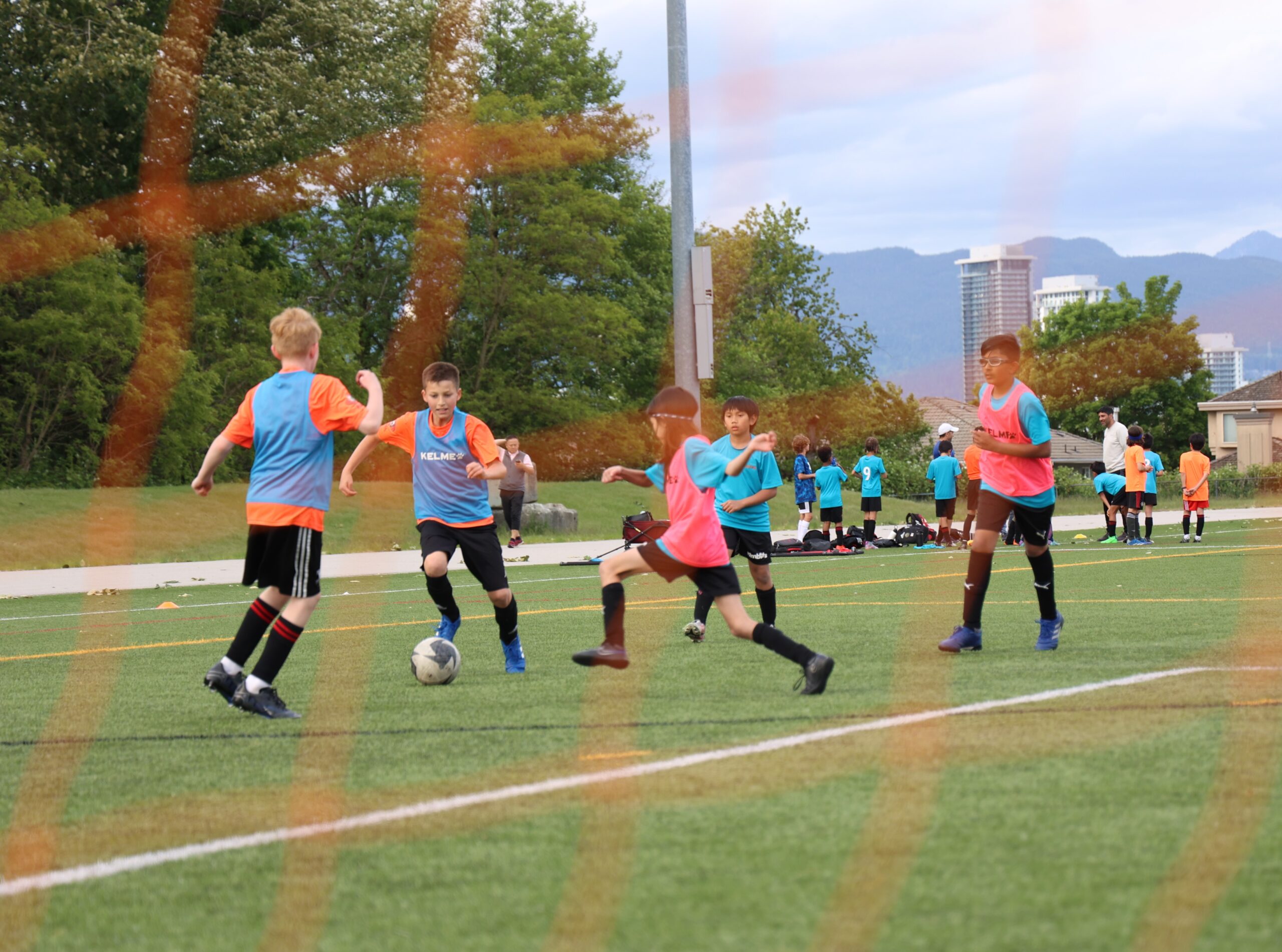Youth soccer follows different principles than professional soccer. Professional matches prioritize winning above everything else, but young players just need a more balanced approach to become skilled at essential techniques like dribbling.
Parents and coaches face a vital choice about their young players. Should they encourage quick passing or let kids take on defenders by dribbling? Several factors influence this decision – the player’s age, skill level, and long-term growth goals. Passing helps develop team play. However, dribbling builds a young player’s confidence, creativity, and basic ball control. Kids Soccer academies like Coquitlam FC in British Columbia use this all-encompassing approach to develop well-rounded players who know when to challenge defenders and when to pass to teammates.
Understanding Youth Development vs Adult Soccer
Youth and adult soccer have a simple but important difference in their goals. Adult soccer puts winning games and league positions first. This shapes how teams train and perform. Youth soccer takes a completely different path.
Different objectives and priorities
Youth soccer’s main goal focuses on helping each player grow instead of team results. Young players need space to explore their abilities. They should build simple skills like dribbling without too much pressure. Studies show that clubs that only care about winning with young players often produce fewer successful long-term players.
The best youth programs focus on:
- Technical skills through lots of ball touches
- Freedom to be creative and make decisions
- Equal time on the field for everyone
- Positive feedback instead of criticism
- Training that matches the player’s age
Why development matters more than winning
Early years in soccer give players the best chance to learn skills. Players need to master simple techniques like dribbling and passing during this time. Studies show that players who build strong technical skills before age 12 show better game understanding and creativity as teenagers.
Age-appropriate expectations
Players need the right goals at the right age to grow. Soccer organizations know that kids aren’t just smaller versions of adults. Each age group needs specific training that matches how they grow and learn.
Kids aged 6-8 should work on ball control and simple movement skills. Players between 9-12 can start learning game tactics while still focusing on technical skills. This step-by-step method, which academies like Coquitlam FC in British Columbia use, helps players build skills naturally instead of rushing into adult-style training.
Success comes from understanding that youth soccer is about growth, not just results. Coaches who focus on proper skills, decision-making, and age-appropriate challenges create the right environment. This approach creates better soccer players and helps them love the game for life.
The Critical Role of Dribbling in Early Development
Recent research in youth soccer development shows interesting findings about the significant role of dribbling skills in player development. A complete study found that children who created dribbling patterns with less space between cones got more touches of the football. The study also showed that players who felt confident about their dribbling skills displayed better fundamental movement skills.
Building fundamental ball control
Players with better soccer dribbling scores excel in fundamental movement skills. Research shows that dribbling performance scales to children’s perceived action capabilities. This allows them to shape their own skill development. Young players who learn simple dribbling techniques show:
- Better spatial awareness and coordination
- Better balance and agility
- Improved ball control under pressure
- Superior decision-making capabilities
Developing confidence and creativity
Studies show that dribbling confidence directly links to overall soccer performance. Children who saw themselves as better dribblers created dribbling patterns with closer spacing. This led to more touches on the ball. In spite of that, players must balance this confidence with proper technique development.
Natural progression of skill acquisition
Dribbling skills develop in a natural pattern. Research reveals that players who created patterns with less space between cones showed better ball control. They achieved more touches in their dribbling task. Coaches need to understand this progression to guide young players effectively through their development.
Coquitlam FC in British Columbia creates an environment where young players progress naturally through these developmental stages. Their comprehensive approach focuses on skill development and decision-making abilities. This ensures players build strong foundations in dribbling techniques.
The link between perceived and actual ability creates an interesting feedback loop that shapes how young players tackle dribbling challenges. Players who feel confident in their abilities often try more complex dribbling patterns. This helps them develop advanced skills faster.
When Passing Should Enter the Picture
The right moment to teach passing skills plays a vital role in a young player’s development pathway and leads to long-term success. Research shows that proper timing in teaching passing techniques can substantially affect a player’s overall growth in the sport.
Age-appropriate passing introduction
Players need to focus on individual ball mastery through dribbling until they reach age 8. Their natural interest in working with teammates emerges at this stage. Research suggests that teaching simple passing concepts between ages 8-10 creates optimal skill development.
Players must master fundamental ball control as they advance through these developmental stages. Coaches should watch for their players’ comfort with simple dribbling skills before they emphasize passing techniques.
Signs of tactical awareness readiness
Several indicators show when players are ready for structured passing instruction:
- Consistent ball control while dribbling
- Regular scanning of the field during play
- Natural tendency to look for teammates
- Simple understanding of spatial concepts
- Knowing how to maintain possession under pressure
Progressive teaching approaches
Research shows that effective passing instruction follows a structured progression. Coaches should implement training methods that build complexity step by step:
- Static passing between partners
- Passing while moving
- Passing with defensive pressure
- Combination play with multiple players
Training sessions should blend both technical and tactical elements. Players must understand not just how to pass, but when passing helps the team versus keeping possession through dribbling.
Coquitlam FC‘s curriculum in British Columbia has proven this progressive methodology works in developing well-rounded players. Their focus remains on proper timing for team-oriented skills while developing individual technical abilities.
Players need careful assessment of their developmental readiness as they move from individual to collaborative play. Research shows that rushing this progression can hurt both individual skill development and tactical understanding. Patient and observant coaches introduce passing concepts gradually as their players show readiness through technical proficiency and game awareness.
Creating the Right Learning Environment
The life-blood of effective youth soccer development lies in creating the right learning environment. Recent studies show how sideline behavior can disrupt young players’ development and their enjoyment of the game.
Reducing sideline pressure
Without doubt, excessive sideline pressure from parents and coaches can hurt young players’ performance and development. Successful programs use these elements to build a more positive atmosphere:
- Clear expectations for sideline behavior
- Focus on effort over outcomes
- Positive communication guidelines
- Structured parent education programs
- Designated team managers to monitor sideline conduct
Encouraging creative expression
Young players thrive in environments that let them take risks and express themselves. Players develop better decision-making skills and confidence when they have room to try new techniques. Coaches should design training sessions that:
- Minimize interruptions during play
- Allow players to solve problems independently
- Celebrate creative attempts, whatever the outcome
- Provide adequate time for skill exploration
- Reduce fear of making mistakes
Balanced feedback methods
Effective feedback shapes player development significantly. Players respond best to a balanced mix of encouragement and constructive guidance. Coaches should give feedback right after training sessions or games. This feedback needs to target specific actions and show clear paths for improvement.
Coquitlam FC in British Columbia proves this balanced approach works in developing well-rounded players. Their method creates safe spaces for players to experiment while giving structured guidance. Young players flourish in the academy’s environment because it removes unnecessary pressure and focuses on long-term development instead of quick results.
Careful observation reveals the difference between supportive and distracting behavior on the sidelines. Research groups sideline behavior into three types: supportive, distracting, and hostile. Coaches and parents can work together better once they understand these differences.
Body language and facial expressions send powerful messages to young players about their performance and worth. Youth soccer programs can create environments where players feel safe to express themselves and develop essential skills through these principles.
Decision-Making Framework for Young Players
Research shows how decision-making abilities in youth soccer develop in specific patterns. Players learn game performance (decision-making and execution) before they grasp specific game knowledge.
Simple rules for ball possession
Young players need to become skilled at simple decision-making principles about ball possession. Players show better results in choosing responses than executing them. These principles include:
- Reading the immediate game situation
- Recognizing available space and teammates
- Understanding defensive pressure levels
- Evaluating risk versus reward
- Making quick, decisive choices
Understanding space and positioning
Spatial awareness plays a vital role in developing tactical decision-making. High-level youth players show better command of offensive play and individual aspects of the game in both knowledge and game situations.
Players need to learn:
- Scan surroundings continuously
- Position themselves between defenders
- Create passing angles
- Maintain appropriate distances
- Make use of width and depth
Progressive complexity by age
Tactical decision-making develops based on age and cognitive maturity. Older players make faster and better first decisions than younger players. This happens because their cognitive processes and game understanding grow together.
Research shows that players aged 9-13 years old with higher tactical skill levels perform better and explore more options than other teams. This suggests that proper tactical training at the right age produces better results.
Decision quality improves with age and experience naturally. Teams with players who have higher tactical skill levels explore more options and achieve better results. This shows why age-appropriate tactical instruction matters so much.
Coaches at Coquitlam FC in British Columbia apply this research through well-laid-out training sessions. Their method builds up complexity in decision-making scenarios gradually. Players develop at their own pace while facing appropriate challenges.
Technical skills and tactical decisions become more connected as players progress. Players with better tactical awareness perform better in both decision-making and execution. This connection shows why developing both aspects remains key to long-term player success.
Building Complete Players at Coquitlam FC
Soccer players need different training approaches at youth and professional levels. Soccer academies have found that developing complete players takes careful attention to both physical and mental aspects of the game.
A Complete Development Approach
A complete development strategy covers several vital elements that work together. Soccer academies of all sizes focus on:
- Technical proficiency – mastering simple skills like how to dribble in soccer
- Tactical understanding – reading game situations
- Physical development – age-appropriate conditioning
- Mental growth – building confidence and resilience
- Social skills – teamwork and communication
Players who train in programs that emphasize all these aspects show better development than those who focus only on technical skills. This comprehensive approach will give young athletes the complete skillset they need to succeed.
Balance of Skills and Decision-making
Technical abilities combined with tactical awareness create the foundation for complete player development. Young players must learn not just what to dribble in soccer but understand when to dribble versus when to pass.
Players advance through these developmental stages:
- Movement literacy (ages 4-6)
- Technical foundations (ages 6-8)
- Game understanding (ages 8-11)
- Advanced skills (ages 11-14)
- Competitive development (ages 14+)
Players who receive balanced training in both skills and decision-making perform better in competitive situations. This balanced approach guides athletes to adapt to various game scenarios.
Long-term Athlete Development Model
The long-term athlete development framework creates a clear pathway for player progression. Research confirms that age-appropriate training methods produce substantially better results than rushing development.
This model emphasizes different aspects at each stage:
Stage 1: Active Start (U4-U6)
- Focus on fundamental movements
- Introduction to simple ball control
- Fun-based activities
Stage 2: FUNdamentals (U6-U8/U10)
- Simple soccer skills including how to dribble in soccer
- Introduction to simple tactics
- Modified game formats
Stage 3: Learn to Train (U8/U11-U11/U12)
- Advanced technical skills
- Simple tactical concepts
- Small-sided games
Coquitlam FC in British Columbia uses this research-based approach. Their program structure reflects how young athletes learn and develop. The academy’s method prioritizes individual growth while maintaining appropriate competitive challenges for each age group.
Physical literacy is the life-blood of early development. Technical skills like dribbling and passing come in gradually as players mature. Coaches help players master fundamental movements before moving to complex skills through well-laid-out training sessions.
Players need individual attention on their development path. Those who progress through these stages naturally, without skipping steps, show better technical abilities and decision-making skills in their teenage years.
Training combines structured drills and free play. Young players can try new skills in a supportive environment. This balanced approach develops creative, confident players who understand both technical and tactical aspects of the game.
The focus stays on long-term development instead of quick wins. Academies create an environment where players can reach their full potential by prioritizing proper skill development and decision-making over immediate results.
Conclusion
Youth soccer is completely different from the adult game. Professional matches just need immediate results, but young players require patience, understanding, and a long-term vision. Players must master basic skills like dribbling before they can tackle complex tactical elements like well-laid-out passing plays.
Successful development programs focus on individual growth through proper skill building instead of rushing young players into adult-style tactics. Technical mastery, decision-making abilities, and age-appropriate challenges help players develop naturally. These are the building blocks of success.
Soccer excellence requires the right balance. Young athletes should feel free to experiment with the ball. They also need to learn when passing helps the team more than taking on defenders. Coaches become vital guides who create supportive environments. This allows young players to build confidence and proper technique without fearing mistakes.
Coquitlam FC in British Columbia shows how this balanced approach creates well-rounded players. Their methods prove that focusing on basics during early years builds superior technical abilities. Players develop better tactical understanding as they move into competitive levels.
Youth soccer’s main goal should be player development, not match results. Parents and coaches who understand this difference create the right environment. Young players can become skilled at the beautiful game and find success both on and off the field.
FAQs
Q1. At what age should children focus on passing in soccer? Passing skills should be introduced gradually around ages 8-10, once players have developed basic ball control through dribbling. However, the exact timing depends on each child’s individual development and readiness.
Q2. Why is dribbling important for young soccer players? Dribbling is crucial for developing fundamental ball control, confidence, and creativity in young players. It helps build spatial awareness, balance, and decision-making skills that form the foundation for more advanced techniques later on.
Q3. How can parents create a supportive environment for youth soccer development? Parents should focus on encouraging effort over outcomes, avoid excessive sideline pressure, and allow children to experiment and make mistakes. Creating a positive atmosphere that celebrates creative attempts helps foster long-term player growth.
Q4. What’s the right balance between dribbling and passing for youth players? The balance depends on the player’s age and skill level. Younger players should focus more on dribbling to develop ball control, while passing can be gradually emphasized as they grow older and gain more tactical awareness.
Q5. How does Coquitlam FC approach youth soccer development? Coquitlam FC uses a holistic development approach that balances technical skills, tactical understanding, and decision-making abilities. They follow a long-term athlete development model, emphasizing age-appropriate training methods to create well-rounded players.
Show facts


